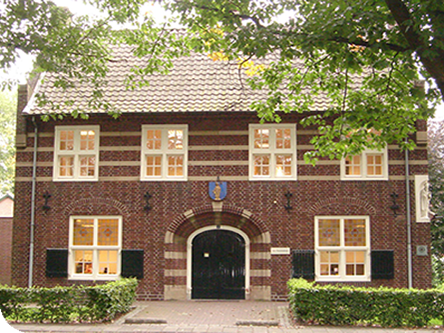Parochiehuis | Bakel
By the turn of the 19th to 20th centuries, farmers were in bad shape. They were working under outdated production conditions at low prices. The establishment of the various farmers' unions, including the one in Bakel, brought much improvement to this. The farmers' union was strongly influenced by the clergy as evidenced, among other things, by the establishment of this parish house, a textbook example of the very traditional village Delfse School style, which was common in Brabant, especially in village and rural areas. This was intended for meetings and gatherings of religious societies and the Bakel Farmers' Union financed it in large part.
Bakel. The very beautiful parish house with theater hall.
In 1891, the pope issued the …
By the turn of the 19th to 20th centuries, farmers were in bad shape. They were working under outdated production conditions at low prices. The establishment of the various farmers' unions, including the one in Bakel, brought much improvement to this. The farmers' union was strongly influenced by the clergy as evidenced, among other things, by the establishment of this parish house, a textbook example of the very traditional village Delfse School style, which was common in Brabant, especially in village and rural areas. This was intended for meetings and gatherings of religious societies and the Bakel Farmers' Union financed it in large part.
Bakel. The very beautiful parish house with theater hall.
In 1891, the pope issued the encyclical Rerum Novarum. An encyclical is a letter to every Roman Catholic, and this encyclical dealt with the social threats of the Industrial Revolution. Many workers were very poor and working conditions abysmal. The pope called for cooperatives. Father Van den Elsen, born in Gemert, took up this idea for the farmers. Agriculture was in crisis, prices were bad and production conditions dated back centuries. The farmers' union was born, and grew rapidly, in 1896 there were already 61 farmers' unions. The farmers' union of Bakel was also founded in 1896. Cooperatives got a lot done, partly also because the parish priests were so closely involved. Worth mentioning is Pastor Roest of Deurne who promoted fertilizer through numerous trial fields and published his own agricultural magazine, Rust Roest. Fertilizer allowed numerous other innovations to be implemented, and the large-scale Peel reclamations carried out at that time gave starting farmers new land for their farms. Cooperative milk factories, butter factories, the farm lending bank, all were initiatives that improved the conditions of farmers. The close cooperation of the clergy with the Farmers' Union is also evident in this parish house, a National Monument, built in 1938, largely with money from the Farmers' Union.
The Catholic Church continued to flourish in the first half of the twentieth century, especially before World War II. This parish house was a building from which the many different church associations could be managed and where they could gather. For example, there was the patronage, an association for boys and girls aged 12 to 18 (separate, by the way) that guided them in their ecclesiastical and social formation after they finished elementary school and went to work. There was also the parochial almshouse that took care of the poor of its own parish and many others that often had to do with youth formation and welfare. Probably the farmers' union also often met in the parish house. The building also had a large theater hall with room for about 350 people, the brass band of Bakel, Musis Sacrum did still give concerts here.
Today it is a wedding venue and the rooms are rented out. The exterior of the building has not changed since its original construction, and the shield and statue of St. Willibrordus, the patron saint of the Bakel parish are clearly visible. The building was erected in the Delft School style. This was a style that was especially popular before World War II and was based on the Brabant village; it favored the use of brick and of simple, historic forms. For government and church buildings, more embellishments were allowed, which were then often of natural stone, including here the tufa statue of St. Willibrordus and the light-colored tufa "speklagen" between the brick.
Sources:
W. van den Berk, One hundred years NCB Bakel: 1896-1996, 1996, Nuntio Publishing House, Nuland
M. van Hees, D. Verhoeven, Voor ziel en zaligheid: Theorie en praktijd van de Rooms-Katholieke opvoeding in oostelijk Noord-Brabant, 1900-1930, 1987, Rijksuniversiteit Utrecht, Utrecht
RCE, Monument description

